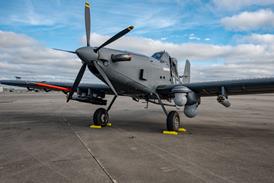HORIZON AIR, the Alaska Air Group regional operator, has received US Federal Aviation Administration approval to operate its fleet of de Havilland Dash 8s to Category IIIa minima, using a Flight Dynamics head-up guidance system (HGS).
The clearance enables Horizon to land the Dash 8 in visibility conditions as low as 215m (700ft) runway-visual range (RVR), making it the worlds first operator of Cat IIIa-approved turboprops. The HGS-equipped aircraft will also be able to take off in conditions as low as 92m RVR at Cat II- and Cat III-qualified airports. Horizon will equip 23 Dash 8s with the HGS.
Two other operators, Southwest Airlines and Ryan International, are also beginning operations with the HGS. Southwest, which ordered 236 systems for $50 million in August 1994, will have around 100 Boeing 737s equipped by the end of 1995 and hopes to have Cat IIIa landing approval and 92m RVR take-off approval in late 1996.
Ryan International, a Boeing 727-100 operator based in Wichita, Kansas, has also obtained FAA approval to operate its 17-strong fleet to Cat IIIa landings using the HGS.
SkyWest Airlines, the Delta Air Lines regional carrier, is expected to become the first airline to be certificated with lateral and vertical-coupled guidance on global- positioning system (GPS) non-precision approaches, following completion of flight testing of new avionics on an Embraer EMB-120.
The SkyWest EMB-120 has been fitted with a Universal Avionics System UNS-1M navigation-management system upgraded with three-dimensional GPS approach capability. The UNS-1M will also allow for GPS stand-alone navigation, GPS overlay (DME-VOR, VOR and NDB), RNAV, DME-VOR and VOR approaches.
SkyWest plans to use the UNS-1M for direct routings, as well as for GPS approaches into airports in difficult terrain.
Source: Flight International























